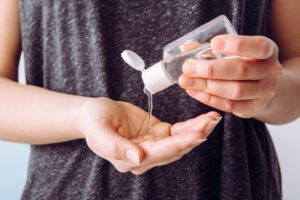What is in Hand Sanitizers and How Do They Work? |

Plastic containers of hand sanitizer are appearing everywhere—at restaurant counters, offices, gyms, even in campground pit toilets. And no wonder, keeping hands clean through proper hand hygiene is a proven way to avoid getting sick and to prevent spreading germs. According to the Centers for Disease Control (CDC), the standard for this is washing with soap and clean running water for at least 20 seconds. But what about hand sanitizers—do they work as well as soap and water, what are they made of, and how are they most appropriately used?
What’s in hand sanitizer? The most effective sanitizers have a form of alcohol, such as ethyl alcohol, that serves as an antiseptic. To be effective, though, hand sanitizers should contain at least 60% alcohol. Two of the most popular brands of hand sanitizers, Germ-X and Purell, each contain ethyl alcohol at a concentration above this level. Other ingredients may include water, vitamin E, fragrance, and glycerin.
How effective are hand sanitizers? Popular hand sanitizers advertise that they are effective at eliminating “over 99.99%” of common germs and bacteria. At appropriate concentrations, alcohol-based sanitizers are effective against most bacteria, viruses, and fungi. This includes the virus that causes the flu as well as the bacteria responsible for causing methicillin-resistant staph infections (MRSA). Unfortunately, with too little volume of sanitizer or an insufficient amount or contact time, the 0.01% of “germs” not reliably killed includes noroviruses. These are the viruses that have been responsible for causing a number of epidemics of gastrointestinal illness on cruise ships. In this setting, the CDC recommends that washing hands with warm water and soap is still the best way to prevent spread of germs.
What is the proper way to use sanitizers? Hand sanitizers are packaged in a variety of ways including plastic pump bottles, personal size bottles, and soft wipes. The amount necessary for sanitizing varies among products but is usually one or two pumps from a bottle or enough to thoroughly cover the hands. Once applied to the palm of the hand, the product should be rubbed over all surfaces of the hands and fingers until dry. It’s important to remember that alcohol-based sanitizers kill germs on contact, but has no residual germ-killing effect. Once it has evaporated, the germ-killing action stops. If re-exposed to germs, as for example after caring for someone who is sick, the sanitizer would need to be used again.
Are hand sanitizers as effective as hand washing? The CDC considers washing hands with soap and water to be the best way to reduce the spread of disease-causing germs. Even the manufacturers of hand sanitizers point out that they are designed to kill germs when access to soap and water is not available. Also, the effectiveness of hand sanitizers if greatly reduced if the hands are visibly dirty. If soap and water are not available, however, sanitizers that contain at least 60% alcohol are the next best way to kill disease-causing germs.
Some of the most appropriate times to wash hands or use a hand sanitizer are:
- Before, during and after handling or preparing food
- Before eating
- After using the bathroom
- After handling animals or animal waste
- When your hands are dirty
- After sneezing, coughing or blowing your nose
- Before dressing a wound, giving medicine or inserting contact lenses
- After changing a diaper
- When caring for someone who is sick
Hand sanitizers have provided a convenient way to clean your hands when conventional washing with soap and water is not possible. There are concerns related to their use, however, including the elimination of beneficial as well as harmful bacteria from the body, and the potential for producing antibiotic-resistant strains of bacteria. When used in appropriate circumstances, though, hand sanitizers can help to keep us from getting sick or spreading germs to others.
If you have any more questions just Ask Hanna, our health advisors are here to help.
Image: ©Shutterstock / FotoHelin








